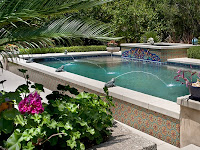Swimming Pool Acid Wash Tips
Like anything, an acid wash has a learning curve, and I suggest you team up with another pool pro as a helper before setting out on your own to do an acid wash. You also need to be aware of your city's codes on draining a pool and also be mindful of a few significant cautions, which I will unpack below, such as don't drain a pool directly into the street, don't drain a pool if the air temperature is 90 degrees or hotter and leave it empty for more than a day and don't drain the water directly into the dirt or grass next to the pool.
If the plaster has cracks and chips in it already, Acid Wash will worsen things. There will be more chipping, and bigger chunks of plaster will start to come off once the pool is refilled. A Pebble Tec pool with pebbles coming off or cracks indicates that an Acid Wash should not be done. This will make the Pebble Tec surface worse and not better.
You also want to be careful not to drain a pool if the outside air temperature is above 90 degrees. This can also cause the plaster to chip, but only once you refill the pool. Sun exposure at that temperature will weaken the old plaster, and the chipping will appear over time. So, scheduling the Acid Wash off-season would be optimal when the weather is milder.
The Acid Wash mix is the most crucial element of Acid Wash. Here are the products that you need for a successful acid wash. You will need 31.45% Muriatic Acid mixed with water in a 2 to 1 water-to-acid mix. Bio-Dex Plaster White' n Brite helps thicken the acid solution so that it runs smoothly down the pool walls and reduces the acid fumes. Bio-Dex AquaDex 50 Stain-Off helps remove iron and other metal staining from the surface. If you use this Acid Wash mix, you will have great results, and the plaster or Pebble Tec will look as good as new!
You can prep the pool to remove some of the calcium buildup on the tile with the Bio-Dex Protect-All-Supreme, which will require you to raise the water level over the pool tile calcium line, pour in 1 or 2 gallons of the Protect-All-Supreme into the pool, and then run the pool for 24-48 hours. In most cases, this is probably not something that most customers will opt to do since almost all of the acid washes I have done were in pools that needed to be drained immediately. But it is a part of the treatment and something you can do as the first step.
Here are the detailed instructions from Bio-Dex on how to do an Acid Wash the Bio-Dex way:
I modified their method because it calls for mixing everything in a 5-gallon bucket and pouring it down the sides. But I have always done my acid washes using a Water Pot, the easiest and most effective method. So, in the video, I also show you the watering pot mixture.
Acid Wash Tips:
Always wear protective gear, as the fumes and Acid are hazardous.
The first thing you should know when you do an Acid Wash is that the results cannot be predicted. I can look at a pool now and predict the outcome. However, each pool is different, and results vary.
You also want to avoid draining a pool when the water table is high. If you have 3-6 inches of rain coming your way, do not drain a pool, as it could potentially pop out. You also want to avoid draining the water into an area around the pool. The ground can absorb the water, creating a situation where the pool can pop out. This is rare and something you don't need to worry about. You, of course, only want to Acid Wash a plaster of Pebble Tec pool and never Acid wash a Fiberglass pool.
If the pool has heavy calcium staining on the surface, organic and metal staining can be trapped under the calcium. You can check for calcium before draining the pool simply by feeling the pool surface.
If it feels very rough, like sandpaper, chances are there is a lot of calcium buildup on the surface. Before doing the Acid Wash, you must power sand the pool surface. You can rent a power sander at Home Depot and then sand down the entire pool surface before the Acid Wash. During Acid Wash, take some sandpaper and rub the area if the staining is not lifting off. Then, pour the acid mix over the area again. If the stain lifts, you know there is a coat of calcium buildup on the surface, and you will have to power sand the entire pool.
Never use just straight Acid on the surface. This will etch and damage the surface and create the plaster's streaking. If the stain is not coming off, calcium is probably the issue and not the acid mix.
The basin in the deep end is very critical. I always add Soda Ash to the basin and leave the Sump Pump (Submersible Pump) running so that the Acid running off the walls does not pool up and stain the plaster. If this happens, once the pool is filled, you will see a discolored ring around the deep end. So, keep the basin filled with Soda Ash or Baking Soda to neutralize the Acid as it runs into the deep-end basin and out through the Sump Pump.
Visit my Website: http://www.swimmingpoollearning.com/

Comments
Post a Comment